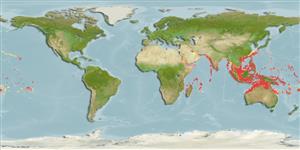>
Carangaria/misc (Various families in series Carangaria) >
Sphyraenidae (Barracudas)
Etymology: Sphyraena: Greek, sphyraina, -es = the name of a fish (Ref. 45335).
Eponymy: Johann Reinhold Forster (1729–1798) was a German clergyman in Danzig (now Gdansk, Poland). [...] (Ref. 128868), visit book page.
More on author: Cuvier.
Environment: milieu / climate zone / Tiefenbereich / distribution range
Ökologie
seewasser riff-verbunden; tiefenbereich 6 - 300 m (Ref. 1602). Tropical; 30°N - 23°S, 36°E - 140°W
Indo-Pacific: East Africa to Southeast Asia and the Marquesan and Society islands, north to southern Japan, south to New Caledonia.
Size / Gewicht / Alter
Geschlechtsreife: Lm ? range ? - ? cm
Max length : 92.3 cm FL Männchen/unbestimmt; (Ref. 125599); common length : 50.0 cm TL Männchen/unbestimmt; (Ref. 9768); max. veröff. Gewicht: 4.1 kg (Ref. 125599)
Rückenflossenstacheln (insgesamt) : 6; Rückenflossenweichstrahlen (insgesamt) : 9; Afterflossenstacheln: 2; Afterflossenweichstrahlen: 9. Body elongate and sub cylindrical with small cycloid scales; head long and pointed. Mouth large and horizontal, the tip of the lower jaw protruding; intermaxilla non-protractile. Preoperculum broadly rounded. Lower limb of the first fill arch with spiny tubercles. First dorsal fin origin opposite or before the pectoral tip, the first spine shorter than the second. Color is generally blackish above and silvery below.
Body shape (shape guide): elongated; Cross section: oval.
Nocturnally active, but occurring in large schools above lagoon patch reefs and along outer reef slopes during the day (Ref. 9768, 48637). Feeds mainly on fishes, but also on penaeid shrimps and squids. Sold fresh, frozen or dried salted. Reports of ciguatera poisoning need confirmation.
Life cycle and mating behavior
Geschlechtsreife | Fortpflanzung | Ablaichen | Eier | Fecundity | Larven
Rose, J.H., 1984. Sphyraenidae. In W. Fischer and G. Bianchi (eds.) FAO species identification sheets for fishery purposes. Western Indian Ocean (Fishing Area 51). Vol. 4. FAO, Rome. pag. var. (Ref. 4752)
IUCN Rote Liste Status (Ref. 130435: Version 2025-1)
Bedrohung für Menschen
Reports of ciguatera poisoning (Ref. 30298)
Nutzung durch Menschen
Fischereien: kommerziell
Tools
Zusatzinformationen
Download XML
Internet Quellen
Estimates based on models
Preferred temperature (Ref.
123201): 19.4 - 28.2, mean 26.2 °C (based on 976 cells).
Phylogenetic diversity index (Ref.
82804): PD
50 = 0.5000 [Uniqueness, from 0.5 = low to 2.0 = high].
Bayesian length-weight: a=0.00724 (0.00481 - 0.01092), b=2.92 (2.80 - 3.04), in cm total length, based on LWR estimates for this species & Genus-body shape (Ref.
93245).
Trophic level (Ref.
69278): 4.4 ±0.0 se; based on diet studies.
Widerstandsfähigkeit (Ref.
120179): niedrig, Verdopplung der Population dauert 4,5 - 14 Jahre. (Preliminary K or Fecundity.).
Fishing Vulnerability (Ref.
59153): High vulnerability (61 of 100).
🛈
Nutrients (Ref.
124155): Calcium = 16 [7, 42] mg/100g; Iron = 0.289 [0.130, 0.614] mg/100g; Protein = 20.1 [18.1, 21.7] %; Omega3 = 0.103 [0.048, 0.214] g/100g; Selenium = 46.3 [20.1, 115.3] μg/100g; VitaminA = 46.7 [10.3, 220.9] μg/100g; Zinc = 0.448 [0.286, 0.779] mg/100g (wet weight);
